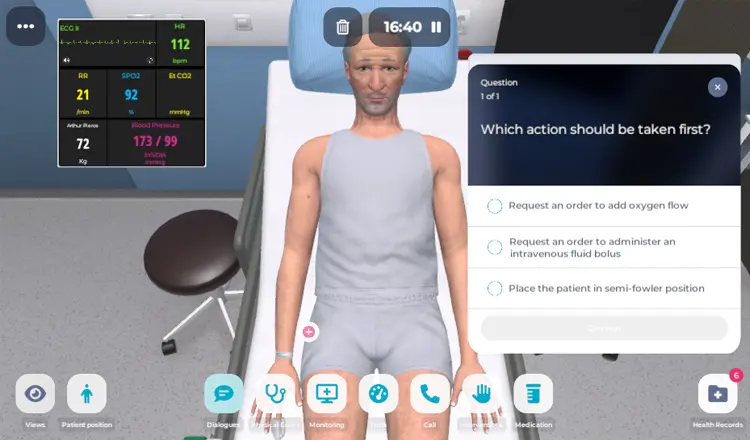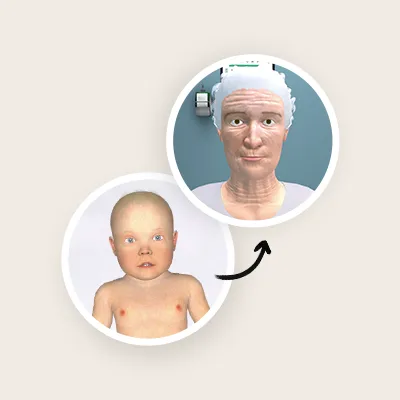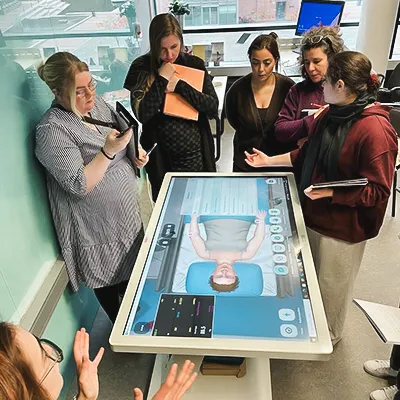How to Develop Nursing Competencies with Virtual Patient Simulation
Developing nursing competencies is critical to preparing future nurses for the demands of healthcare. The American Association of Colleges of Nursing (AACN) outlines these in The Essentials: Core Competencies for Professional Nursing Education. Virtual patient simulations, like Body Interact, provide an innovative and effective way to develop these competencies.

Why Virtual Patient Simulations?
Virtual patient simulations allow nursing students to engage with realistic scenarios that mirror the complexities of clinical practice. These simulations provide opportunities to practice skills and make clinical decisions in a safe, risk-free environment.
Here’s how Body Interact, in particular, is an excellent tool for developing key nursing competencies based on the AACN Essentials:

1. Patient-Centered Care
Patient-centered care emphasizes understanding and addressing patients’ physical, emotional, and psychological needs.
Through Body Interact, nursing students can engage with virtual patients who present with a variety of conditions and backgrounds. This allows students to develop empathy and improve their ability to assess and address patient concerns, all while practicing history-taking, active listening, and communication skills.
2. Evidence-Based Practice
The Essentials emphasize the importance of integrating evidence into clinical practice. Body Interact provides access to virtual patients, where the students can gather diagnostic information and then apply evidence-based guidelines to make treatment decisions.
By simulating a broad range of conditions and interventions, students can refine their ability to synthesize clinical data and research while reinforcing the importance of evidence-based practice in nursing.
3. Informatics and Technology
As healthcare becomes increasingly digitized, proficiency in informatics is vital for modern nurses. Body Interact leverages technology to create realistic, interactive simulations that allow students to learn how to use digital health tools for patient assessment, diagnosis, and treatment planning. By engaging with these tools, students improve their clinical judgment and become familiar with the technologies they will encounter in real-world settings.
4. Communication
Effective communication is crucial in nursing practice. Virtual simulations allow nursing students to practice and refine their communication skills in various scenarios.
From explaining a diagnosis to a patient to collaborating with a healthcare team, Body Interact helps students practice verbal and nonverbal communication. This ensures they can navigate difficult conversations and provide patients and team members with clear instructions.
5. Safety and Critical Thinking
Patient safety is a cornerstone of nursing practice. Virtual simulations allow students to make critical decisions without the risk of harming actual patients. Body Interact, in particular, will enable students to test their clinical reasoning and critical thinking in high-pressure situations. By encountering complex scenarios, students can practice making informed decisions and responding to patient condition changes, which is crucial in preventing errors and ensuring patient safety.
6. Interprofessional Collaboration
Interprofessional collaboration is another essential competency involving working with various healthcare team members. Body Interact can simulate multi-disciplinary team scenarios, allowing nursing students to practice collaboration and communication with other professionals, even if they are not physically present. This fosters a deeper understanding of teamwork in patient care and prepares students to work seamlessly in real-world healthcare environments.
7. Leadership and Professionalism
Leadership is not just about managing others—it’s about influencing patient outcomes, advocating for quality care, and demonstrating professionalism in all aspects of practice.
Through Body Interact, nursing students can take on leadership roles within patient care scenarios, making decisions that impact the course of treatment. They can also practice self-reflection and better understand their professional values and ethical responsibilities.
Virtual patient simulators, like Body Interact, are complementary educational tools for students to develop nursing competencies. Integrating them into nursing education ensures students are equipped to provide high-quality, patient-centered care while meeting the demands of modern practice.
Want to learn how Body Interact can enhance nursing competencies?
By Ana Santa – MSN, APRN
Editorial Manager









